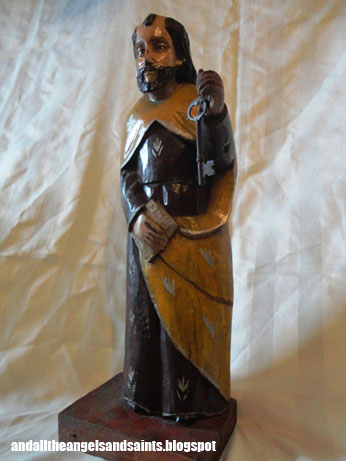The last time I was in Bangkal, Makati was around 2012. Years before, the barangay had established a reputation as the thrift shop center of Makati, where one could find one-of-a-kind vintage items, and even antiques buried in the jumbled assortment of second-hand "pre-loved" items, garage sale consignments, not to mention the debris and detritus of demolished old houses.
But by 2012, the place had been discovered by antique
dealers, and the thrill of the hunt had diminished as the price tags became
more expensive and old item became more scarce. The mishmash of articles
have also been organized, i.e. Italian
decors, Orientalia, etc., stripping the place of its randomness, which was part
of the exciting picking experience.
So, I went there, expecting nothing, and saw nothing—until
I went to the Bangkal depot—that big compound near the end of Evangelista St., where they drop off all the found
items from here and abroad for processing.
There were also stalls there, where objects are laid out on tables and consoles, in disarray. This was more to my liking, my idea of a picker’s paradise—the organized chaos was a sign of many possibilities!! True enough, a table in a back stall caught my eye. For there, behind some kitschy woodcarvings, I espied an antique folk santo, a San Pedro, badly out-of-place amidst crystal ashtrays, resin figurines and decors !!
It’s not a remarkable San Pedro its carving shallow and
unrefined, as all folksy santos are. But its condition is impeccable—its height
alone is 16 inches, inclusive of the half-inch base. Made of medium wood, the
rather hefty santo owes much its charm
to its color, still brilliant all these years. Save for the missing key—San Pedro’s square base, paint, hand, base—are all intact.
The image has been painted with house paint—latex—using just
3 colors—black (San Pedro’s hair), yellow (tunic), and brown (cape). The
tulip-like strokes that decorate the garments are painted in silver paint,
perhaps to mimic metallic embroidery. These floral flourishes, I have seen in
many Visayan santos. The provenance was later confirmed by the Seller.
I had to keep the good saint in my hands, as by then, the place
was swarming with pickers, Mentally, I estimated the price of the santo, all things
considered. When I approached the Seller
to ask for the santo’s price tag, I was stunned (but happy) that it was way
below my estimate. I made an offer, which she gladly accepted, and San Pedro de
Bangkal, the keeper of the gate—was mine to keep.










No comments:
Post a Comment